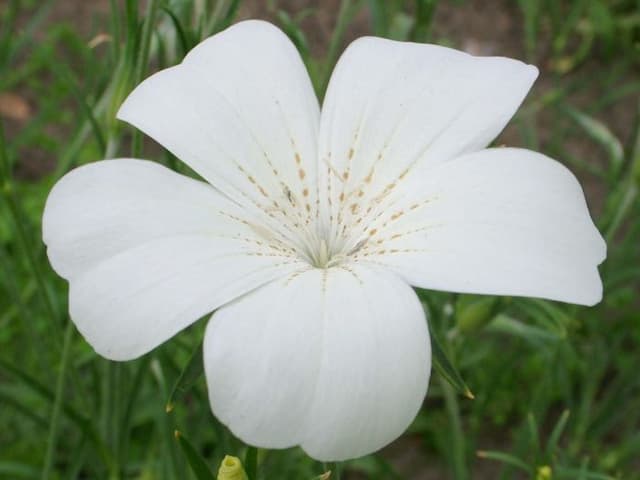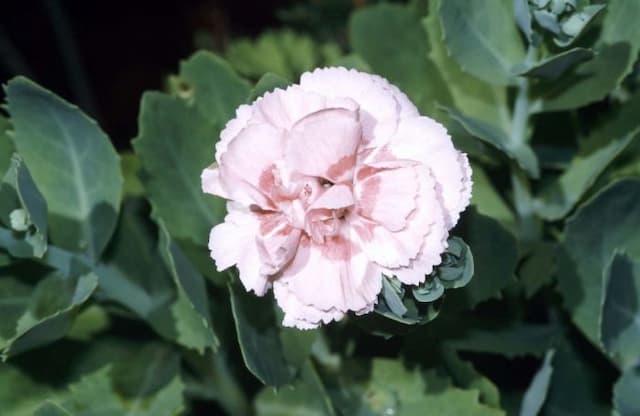Carnation Dianthus 'Oxford Magic' (p)

ABOUT
Dianthus 'Oxford Magic' is a charming plant known for its striking flowers which come in a vibrant mix of colors, typically showcasing a blend of crimson to deep pink hues that might be contrasted with lighter pink or white patterns. The petals are often fringed or serrated, giving them a unique texture that adds to the plant's overall appeal. These blossoms exude a delightful, spicy fragrance that is often described as clove-like, which can be an attractive feature for gardeners and passers-by. Their foliage is slender and bluish-green, forming a neat, low-growing clump. The leaves are typically long and narrow, with a slightly glaucous finish that can make the green look more silvery in certain lights. Together, the plants create a lush, cushion-like appearance that presents the colorful, eye-catching blooms prominently above the foliage. The flowers are usually borne on short, strong stems that rise modestly above the leaves, standing out brightly against the green background. Dianthus 'Oxford Magic' tends to bloom prolifically, producing flowers in abundance, which can provide a long-lasting display of color in the garden. The visual impact of this plant is often used to enhance rock gardens, border fronts, and container displays where its floral beauty and aromatic presence can be appreciated up close.
About this plant
 Names
NamesFamily
Caryophyllaceae
Synonyms
Sweet William, Pinks
Common names
Dianthus 'Oxford Magic'
 Toxicity
ToxicityTo humans
Dianthus 'Oxford Magic', commonly known as Pinks, is not generally considered toxic to humans. There are no significant reports of poisoning from ingesting Pinks. However, as with many plants, it is possible for individuals to have a sensitivity or allergic reaction upon handling or ingesting parts of the plant, but this is not common.
To pets
Pinks (Dianthus 'Oxford Magic') are generally considered safe and non-toxic to pets. There are no widely recognized symptoms of poisoning in pets from ingestion of Pinks. However, gastrointestinal upset is a common symptom for pets when they ingest plant material they are not used to, so it's always best to prevent pets from eating plants that are not part of their normal diet.
 Characteristics
CharacteristicsLife cycle
Perennials
Foliage type
Evergreen
Color of leaves
Blue-green
Flower color
Mixed
Height
1 foot (30 cm)
Spread
1 foot (30 cm)
Plant type
Herb
Hardiness zones
Varies
Native area
Europe
Benefits
 General Benefits
General Benefits- Visual Appeal: The Dianthus 'Oxford Magic' offers vibrant flowers that enhance the aesthetic of gardens and landscapes.
- Low Maintenance: Being a hardy plant, it generally requires minimal care, making it suitable for busy gardeners.
- Attracts Pollinators: The flowers attract bees and butterflies, which are beneficial for pollinating other plants in the garden.
- Pest Resistance: Dianthus species are known to be resistant to many common garden pests.
- Drought Tolerance: Once established, it can tolerate periods of dryness, reducing the need for frequent watering.
- Compact Growth: Its growth habit is usually compact, making it a good choice for borders or small spaces.
- Long Blooming Period: The plant typically has a lengthy flowering season, providing color for an extended time.
- Versatility: Suitable for planting in containers, hanging baskets, as well as garden beds and borders.
 Medical Properties
Medical PropertiesThis plant is not used for medical purposes.
 Air-purifying Qualities
Air-purifying QualitiesThis plant is not specifically known for air purifying qualities.
 Other Uses
Other Uses- Dianthus 'Oxford Magic' or simply pink, can be used in making potpourri due to its fragrant petals, which can help provide a long-lasting pleasant scent in drawers or closets.
- Dried pink petals can also be incorporated into homemade candles to add a subtle fragrance and attractive flecks of natural color.
- Pinks, when pressed, can be used in artistic endeavors such as creating botanical prints or delicate additions to handmade paper.
- These flowers can be used to add a decorative touch to cakes and desserts, as they are both edible and offer a mild spicy flavor.
- Pinks can serve as a natural dye source for textiles, giving fabrics a gentle pink or yellow tint depending on the mordant used.
- When planted in outdoor containers, pinks can be used as a living mulch to help retain soil moisture and suppress weeds.
- As a garden ornamental, these plants are used to create colorful borders or as part of rock garden compositions.
- Pinks can be used in educational settings, teaching students about plant biology as well as basic horticultural practices.
- In memory gardens or remembrance spaces, pinks can symbolize love and admiration, serving as a living tribute to loved ones.
- These plants, with their attractive blooms and habit, are used in miniature gardens or fairy gardens to create a whimsical landscaping effect.
Interesting Facts
 Feng Shui
Feng ShuiThe plant Dianthus is not used in Feng Shui practice.
 Zodiac Sign Compitability
Zodiac Sign CompitabilityThe plant Dianthus is not used in astrology practice.
 Plant Symbolism
Plant Symbolism- Love: Dianthus flowers, commonly known as "pinks," are often associated with love due to their attractive and vibrant colors.
- Admiration: Their striking appearance has also made them a symbol for admiration, frequently given as a sign of high esteem.
- Passion: The bold hues of Dianthus 'Oxford Magic' can signify deep affection and intense emotional connections.
- Purity: While red Dianthus varieties symbolize love, the white blossoms of some variants can convey purity, suggesting the innocence and clarity of true love.
- Capriciousness: Due to the flower's ruffled edges, Dianthus plants may sometimes symbolize whimsical or capricious behavior in the language of flowers.
 Water
WaterThe Sweet William, commonly known as Dianthus 'Oxford Magic', should be watered regularly to keep the soil moist but not waterlogged. Ideally, water when the soil's surface starts to dry out, typically once a week. Adjust the frequency based on weather conditions; less often during cool, wet spells and more often during hot, dry spells. When watering, apply water directly to the soil rather than overhead to avoid wetting the foliage, which can lead to fungal diseases. A good approach is to provide the plant with about 1 inch of water per week, either from rainfall or manual watering.
 Light
LightSweet William thrives in a location that receives full sun, which means at least six hours of direct sunlight each day. The best spot for these plants is in a garden bed or container where they can bask in the sunshine while being shielded from harsh afternoon light in extremely hot climates. Partial shade is acceptable, but too little light may result in fewer blooms and leggy plants.
 Temperature
TemperatureSweet William prefers moderate temperatures and will perform well in areas where the daytime temperatures are between 60 to 75 degrees Fahrenheit. They can survive minimum temperatures down to around 40 degrees Fahrenheit and are generally cold-hardy. Avoid placing the plant in locations where temperatures dip lower or exceed 80 degrees Fahrenheit as extreme temperatures can stress the plant.
 Pruning
PruningPruning Sweet William is important to encourage bushier growth and more flowers. Deadhead spent blooms to prevent the plants from self-seeding excessively and to promote continued blooming. After the first flush of flowers diminishes, cut back the stems by one-half to stimulate a second bloom. The best time for pruning is late spring or early summer after the first wave of flowering has finished.
 Cleaning
CleaningAs needed
 Soil
SoilFor Carnation 'Oxford Magic', the best soil mix is well-draining with a loamy or sandy texture, enriched with organic matter. The soil pH should be neutral to slightly alkaline, ranging from 6.7 to 7.5.
 Repotting
RepottingCarnations like 'Oxford Magic' do not need frequent repotting; it should be done every 2-3 years or when the plant outgrows its container.
 Humidity & Misting
Humidity & MistingCarnation 'Oxford Magic' prefers average ambient humidity and does not require a highly humid environment.
 Suitable locations
Suitable locationsIndoor
Place in bright, indirect light and ensure good air circulation.
Outdoor
Ensure full sun, shelter from strong winds, and well-drained soil.
Hardiness zone
4-9 USDA
 Life cycle
Life cycleCarnation 'Oxford Magic', a cultivar of Dianthus, begins its life cycle with seed germination, which requires a well-drained growing medium and consistent moisture. Following germination, seedlings emerge and enter a vegetative growth phase, establishing a root system and producing foliage. As the plant matures, flower buds develop and bloom, exhibiting the characteristic vibrant colors and fragrance of carnations. After pollination, either naturally or by human intervention, the plant produces seeds, completing the reproductive cycle. If conditions are not favorable for seed production, or if gardeners deadhead spent flowers, the plant may return to a vegetative state and prepare for the next blooming cycle. Carnation 'Oxford Magic', being a perennial, can repeat this cycle for several years with proper care and seasonal maintenance.
 Propogation
PropogationPropogation time
Spring-Early Summer
The Dianthus 'Oxford Magic', commonly known as the Oxford Magic carnation, is most commonly propagated through stem cuttings. The ideal time for taking cuttings is in late spring to early summer, when the plant's growth is most vigorous. To propagate, select healthy, non-flowering stems and cut a piece around 4-6 inches (10-15 cm) long. Strip the leaves from the bottom half of the cutting and dip the cut end into rooting hormone powder to enhance root development. The cutting should then be planted into a pot filled with a well-draining soil mix, ensuring that the leafless part is submerged. It’s vital to maintain the soil's moisture without making it waterlogged and to provide a warm environment with indirect sunlight. Roots typically develop within a few weeks, after which the new plants can be transplanted.








![Pink [Bubblegum]](/_next/image?url=https%3A%2F%2Fplants-admin.emdemapps.com%2Fimages%2Fplants%2F%2Fimages%2F604b596f31cbb.png&w=640&q=75)
